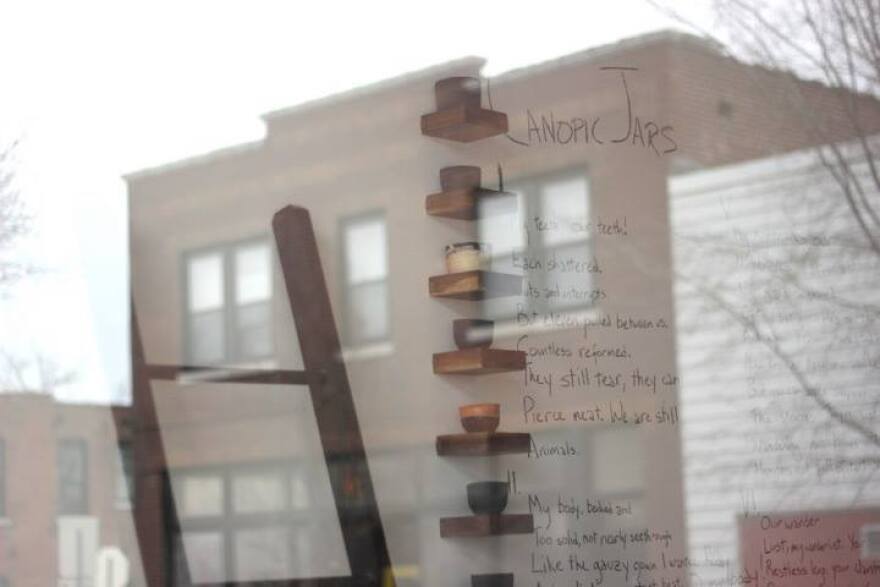Two shows – one by up-and-coming artist and poet John Cummins and Aron Fisher; the other by established St. Louis art world fixtures Buzz Spector and Mary Jo Bang --share more than architecture at the neighboring Fort Gondo and Beverly galleries. These two-person art exhibits, Conversed and Otherwise, pair text and art object that are increasingly interesting as they are explored.
Otherwise
Spector’s east wall contribution to Otherwise, at the new Beverly Gallery on Cherokee, begins and ends with collages of the words “About the Authors.” On the opposite wall, Bang’s art is a mixed media medley with titles that betray an autobiographical impulse. Bang is primarily described as a poet, though her CV is riddled with visual arts expertise. Spector is a visual artist whose practice often involves text and the paper upon which one finds text. Much of Spector’s work reads like that of a man with a book fetish.
Spector and Bang leave quotations along the gallery walls, not “this kind” but the kind of visual quotations that elicit a connection. Spector quotes from book jacket covers and interviews with authors when he makes collages of photographs depicting authors or their book collections. Bang has tied a small antique doll to the gallery wall like bondage, placing a frame around the cute/creepy girl-thing. Her placement of toys in frames and on pedestals quotes childhood. When Bang removes an action figure or a tiny retro camera from the flurry of childhood fun for which it was originally designed, she takes the quotation out of context, throwing it into stark relief.
Conversed

John Cummins and Aron Fischer describe their poetry-art duet Conversed as an evolution of a conversation. Throughout it, Cummins wrote poetry to which Fischer responded in sculptural creations to which Cummins responded, joining text to form, form to text. Their work conjoins fully at times with the presentation of Cummins charcoal written words on installations that Fischer has assembled for the purpose of displaying them.
One source for Cummins poetic quotations is his marital partnership with Fischer. Another is his work as a third-year medical student. His lines of verse are especially poignant when viewed through his biography.
The paradigm in which Fischer roots his artistic practice provides an entre point into his work as well. Fischer describes himself as a “maker.” Outside of the DIY educational setting, in the high art world, this term often refers to the use of practical skills toward novel ends. Terms like “maker” and “tinkerer” have a sort of anti-establishment edge to them in the world of contemporary art.
Fischer has arranged found objects on the Fort Gondo walls and floor, turning plywood scraps into twisting vertebrae and common ceramic vessels into “Canopic Jars.” Cummins’ lines of poetry, often written directly upon the gallery walls, help to complete the transformation of objects into visual quotations that illustrate the poetry.
Biography and art
Spector and Bang’s exhibit at Beverly along with Cummins and Fischer’s show at Fort Gondo can be used to address a 50-year-old conversation regarding the role of the author, and in this case the artist, when interpreting creative production. Can the work stand on its own, perhaps untitled, separate from the artist’s biography? Should art be open to all interpretation, with or without insight into the artist’s intentions?
In 1967, Roland Barthes shook up the French literary world when he wrote that the “death of the author” would lead to the “birth of the reader.” While Barthes’ supposition that creative works ought to be interpreted without reference to their authorship is a theme around which contemporary art sometimes harkens, the art on display at Beverly and Fort Gondo is much more interesting when tied to the authors behind each.
The basics
Where: Fort Gondo and Beverly Galleries: 3151 Cherokee St.
When: closing Feb. 8
Gallery hours: Thursdays and Saturdays 12-4 p.m. and by appointment
Cost: Free
Information: www.fortgondo.com




